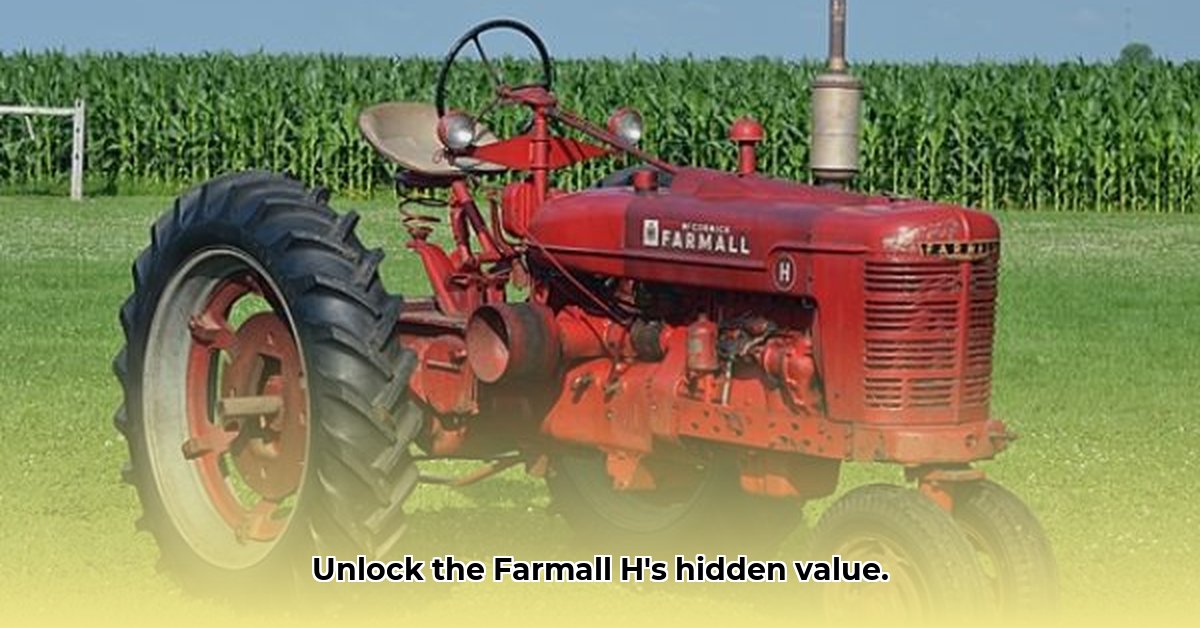
The Farmall H: a name synonymous with agricultural innovation and enduring legacy. This collector's guide delves into the history, variations, and current market value of this iconic tractor, providing essential information for enthusiasts, prospective buyers, and seasoned collectors alike. Whether you're dreaming of a restoration project or seeking a valuable addition to your collection, this guide will equip you with the knowledge to navigate the world of Farmall H tractors. For even more detailed information on a specific year, check out this 1948 Farmall resource.
The Farmall H's Rise to Prominence: A Workhorse of its Time
The Farmall H, introduced in 1939, wasn't just another tractor; it revolutionized farming. Its simple yet robust design, coupled with its relative affordability and ease of maintenance, quickly made it a favorite among farmers. Its impact extended beyond individual farms; the Farmall H played a crucial role in boosting agricultural productivity during World War II, ensuring food security for both the home front and the troops abroad. This period of intense demand significantly impacted production numbers and contributed to the tractor's enduring popularity. The Farmall H's straightforward design and reliable performance, even under pressure, solidified its place in agricultural history.
Production Numbers and Variations: A Detailed Look
More than 391,000 Farmall H tractors were produced between 1939 and 1953, a testament to its widespread adoption. However, production wasn't uniform; yearly output fluctuated based on economic conditions and wartime demands. Analyzing these production numbers year-by-year reveals interesting insights into the agricultural and economic climate of the mid-20th century. Furthermore, subtle variations exist within the Farmall H line. These variations, often overlooked, significantly impact a tractor's collectibility and value. These variations include different engine options, features added over the years (such as modifications to the PTO shaft or the addition of different accessories), and even subtle cosmetic changes. Careful examination of these details reveals a surprising level of diversity, transforming each Farmall H into a unique piece of history.
Approximate Production Figures (Note: Exact figures vary depending on source):
| Year Range | Estimated Units Produced |
|---|---|
| 1939-1941 | Around 60,000 |
| 1942-1945 | Approximately 150,000 |
| 1946-1953 | Roughly 181,000 |
Market Value Analysis: Factors Influencing Price
Determining the value of a Farmall H involves more than simply checking the year of manufacture. While age is a factor, the condition, completeness, and rarity of specific configurations significantly impact its market value. A meticulously restored, original tractor will command a far higher price than a neglected example requiring extensive work. Rarity plays a key role; certain features or original accessories can dramatically increase a tractor's value among collectors. Even the geographical location can impact demand and therefore influence price. Considering the location during sales affects the price—regional collectors' preferences impact its value.
Simplified Value Guide (USD): (Note: These are estimates, and actual prices vary widely)
| Condition | Estimated Value Range (USD) |
|---|---|
| Excellent | $15,000 - $30,000+ |
| Good | $8,000 - $18,000 |
| Fair | $4,000 - $10,000 |
| Poor | $1,000 - $5,000 |
Collector's Perspective: Insights from Passionate Owners
"The Farmall H community is incredibly supportive," says John Miller, a long-time collector and restorer of vintage tractors. "We share knowledge, parts, and a common passion for these machines. It's more than just collecting; it's about preserving a piece of history." Collectors emphasize the importance of thorough research when assessing a Farmall H's value. They highlight the challenges in sourcing original parts, particularly for rarer configurations, and often advise prospective buyers to meticulously inspect tractors for signs of repairs or modifications before purchasing.
Actionable Steps: A Buyer's Guide
Purchasing a Farmall H requires careful planning and research. Follow these actionable steps to make an informed decision:
- Research: Thoroughly research the specific model and its variations. Identify unique features and assess their impact on value.
- Inspection: Meticulously inspect the tractor. Check for rust, mechanical issues, and missing parts. Consider enlisting a qualified mechanic.
- Market Research: Utilize online resources and collector guides to determine a realistic market value. Compare prices of similar models in comparable conditions.
- Negotiation: Negotiate a fair price based on your research and the tractor's condition.
- Documentation: Secure all relevant documentation, including the title, manuals, and service records.
The Farmall H’s enduring legacy lies not only in its agricultural impact but also in the passionate community it has fostered. Owning a Farmall H isn't just about possessing a piece of machinery; it's about joining a vibrant network of enthusiasts who share a common love for history, restoration, and the unique charm of this iconic tractor.